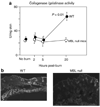Burn injury reveals altered phenotype in mannan-binding lectin-deficient mice
- PMID: 17363917
- PMCID: PMC2936508
- DOI: 10.1038/sj.jid.5700748
Burn injury reveals altered phenotype in mannan-binding lectin-deficient mice
Abstract
Burn injury destroys skin, the second largest innate immune organ in the body, and triggers chaotic immune and inflammatory responses. The pattern recognition molecule, mannan-binding lectin (MBL), plays an important role in the first-line host defense against infectious agents. MBL initiates the lectin complement pathway and acts as an opsonin. Recent studies suggest that MBL also modulates inflammatory responses. We report that local responses after burn in MBL null mice differ from those found in wild-type (WT) mice in the following important biological markers: spontaneous eschar separation, thinned epidermis and dermis, upregulation of soluble factors including cytokines, chemokines, cell adhesion molecules, a growth factor-binding protein, and matrix metalloproteinases. Mice lacking C1q, C4, or C3 did not show the lack of eschar separation seen in MBL null-burn phenotype. These findings implicate MBL as an important molecule in the maintenance of the homeostatic balance.
Conflict of interest statement
J.C. Jensenius and S. Thiel have a financial interest in NatImmune A/S, Copenhagen, the company providing the rhMBL.
Figures




References
-
- Allgower M, Schoenenberger GA, Sparkes BG. Burning the largest immune organ. Burns. 1995;21:S7–S47. - PubMed
-
- Armstrong DG, Jude EB. The role of matrix metalloproteinases in wound healing. J Am Podiatr Med Assoc. 2002;92:12–18. - PubMed
-
- Arturson G. Microvascular permeability to macromolecules in thermal injury. Acta Physiol Scand Suppl. 1979;463:111–122. - PubMed
-
- Botto M, Dell’Agnola C, Bygrave AE, Thompson EM, Cook HT, Petry F, et al. Homozygous C1q deficiency causes glomerulonephritis associated with multiple apoptotic bodies. Nat Genet. 1998;19:56–59. - PubMed
-
- Burke B. The role of matrix metalloproteinase 7 in innate immunity. Immunobiology. 2004;209:51–56. - PubMed
MeSH terms
Substances
Grants and funding
LinkOut - more resources
Full Text Sources
Other Literature Sources
Medical
Molecular Biology Databases
Miscellaneous

